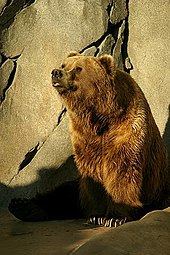Kodiak bear
[2] Subsequent taxonomic work merged all North American brown bears into a single species (Ursus arctos).
Hair colors range from pale blonde to orange (typically females or bears from southern parts of the archipelago) to dark brown.
As soon as the egg is fertilized and divides a few times, it enters a state of suspended animation until autumn when it finally implants on the uterine wall and begins to grow again.
Kodiak bears that have recently left their mothers, at ages 3–5 years, have high mortality rates[3] with only 56% of males and 89% of females surviving.
[23] The islands of the Kodiak Archipelago have a subpolar oceanic climate with cool temperatures, overcast skies, fog, windy conditions, and moderate to heavy precipitation throughout most of the year.
Although the archipelago only covers about 13,000 km2 (5,000 sq mi), a rich variety of topography and vegetation ranges from dense forests of Sitka spruce on the northern islands, to steep, glaciated mountains rising to Koniag Peak's 1,360 m (4,470 ft) along the central spine of Kodiak Island, to rolling hills and flat tundra on the south end of the archipelago.
[19] Bears live throughout the archipelago, adapting to local resources and retaining relatively small home ranges and comparable densities in most habitats.
In the late summer and early fall, bears consume several types of berries when they reach their ripest point, and have the highest levels of sugar.
When eating deer, mountain goats, elk, or cattle, internal organs are eaten first for their high-fat content, however even though there is an abundance of the animals found on the archipelago, few Kodiak bears actively prey on them as other methods of finding food are more energy efficient.
Kodiak bears are generally solitary in nature; however, when food is concentrated in small areas, such as along salmon spawning streams, grass/sedge flats, berry patches, a dead whale, or even an open garbage dump, they often occur in large groups.
To maximize food intake at these ecologically important areas, bears have learned to minimize fighting and fatal interactions by developing a complex communication (both verbal and body posturing) and social structure.
The most notable exceptions to this behavior pattern occur when bears are surprised, threatened, or attracted by human food, garbage, or hunter-killed game.
One of the attacks was fatal, with the hunter being killed by the bear, and occurred on Uganik Island (November 3, 1999), which is part of the Kodiak archipelago.
At that time, Kodiak Natives (Alutiiqs) occasionally hunted bears, using their meat for food, hides for clothing and bedding, and teeth for adornment.
At the same time, sportsmen and scientists had recognized the Kodiak bear as the largest in the world, and they voiced concerns about overharvesting the population.
[30] Professional interest in guided Kodiak bear hunts and concern for unregulated resource use in frontier lands such as Alaska prompted the territorial government's newly established Alaska Game Commission to abolish commercial bear hunting (selling the hides) on the archipelago in 1925.
To address the dilemma of conserving bears while protecting cattle, salmon, and people, President Franklin D. Roosevelt created the Kodiak National Wildlife Refuge by executive order in 1941.
[36] In 1971, the Alaska Native Claims Settlement Act (ANCSA) resolved many long-standing land issues with Aboriginal Alaskans statewide.
That project included an earthen dam on Terror Lake with Kodiak National Wildlife Refuge and a 10 km (6 mi) tunnel through a mountain ridge to a penstock and powerhouse in the Kizhuyak River drainage.
Bears were not directly harmed by the Exxon Valdez oil spill in 1989, although some were displaced from traditional feeding and traveling areas by cleanup crews.
[33] In 2001, a citizens advisory committee was established to work closely with the Alaska Department of Fish and Game (ADF&G), with the cooperation of Kodiak NWR, to develop a management plan addressing several problems that affect bears, including hunting, habitat, and viewing.
The resulting Kodiak Archipelago Bear Conservation and Management Plan[38] was crafted over several months by representatives from 12 diverse user groups, which, after hearing from a variety of experts from agencies and receiving extensive public input, developed more than 270 recommendations for managing and conserving Kodiak bears.
Although the group's role is merely advisory, government management agencies expressed a commitment to implement all of the regulations that were feasible and within their legal jurisdictions.
Currently, a finely tuned management system distributes hunters in 32 different areas during two seasons (spring: April 1 – May 15, and fall: October 25 – November 30).
Each year, about 4,500 people apply for the 496 permits offered for Kodiak bear hunts (two-thirds to Alaska residents, one-third to non-residents).
All hunters must come into the Alaska Department of Fish and Game office in Kodiak before going into the field for a brief orientation and must check out before they leave the island.
[41] Pelts receive a stamp from an ADF&G officer if the hunter and guide provide proper documentation to prove licensing.
Illegal hunting and fishing is frowned upon by the community which maintains a healthy respect for the island's environmental laws, as well.
The number of large, trophy-sized bears (total skull size at least 70 cm [28 inches]) killed by hunters in recent years has been increasing.
Also, other bear viewing opportunities exist through air-taxi, charter boat, remote lodge, and trekking operations on the archipelago.







